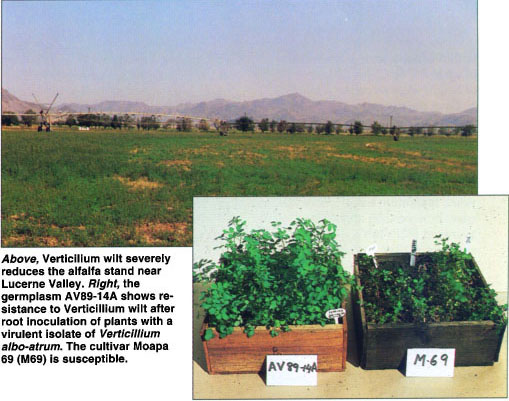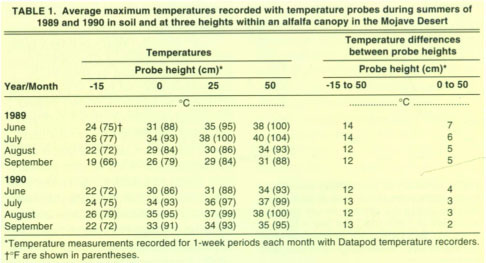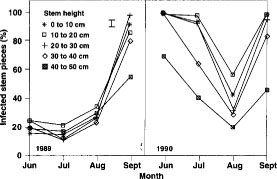All Issues
Verticillium survives heat in Mojave Desert alfalfa
Publication Information
California Agriculture 52(4):24-26. https://doi.org/10.3733/ca.v052n04p24
Published July 01, 1998
PDF | Citation | Permissions
Abstract
Verticillium albo-atrum, the cause of Verticillium wilt of alfalfa, was detected consistently in 1989 and 1990 in alfalfa stems collected from a farm in the Mojave Desert at air temperatures (up to 104°F) above the maximum (86°F) for its growth and sporulation. According to research in other areas of the United States and in Canada, infected alfalfa hay is a prime source of inoculum. Resistance to Verticillium wilt in nondormant germplasms was readily developed by selection in six germplasms that have been released.
Full text
Yellowing at the tips of infected leaves is symptomatic of Verticillium wilt Inset, the plant on the left is healthy. The two on the right exhibit typical foliar symptoms on Verticillium wilt-infected plants.
Verticillium wilt of alfalfa is a systemic disease that primarily affects the xylem (water-conducting) tissue of alfalfa. Diagnostic symptoms include yellowing of leaves near the top of the plant, some of which exhibit a V-shaped yellow area at the tip of the affected leaf (Christen and Peaden 1981), and browning of the xylem tissue in roots. Spores of Verticillium albo-atrum, the cause of the disease, move upward with the flow of water in the xylem tissue. V. albo-atrum resembles V. dahliae, the cause of Verticillium wilt of cotton, but does not produce microsclerotia and hence does not survive as well in soil. The optimum temperature for growth of V. albo-atrum is 75° ± 2°F (24° ± 1°C), with only slight growth at 86°F (30°C) and no growth at 91°F (33°C) (Howell and Erwin 1995).
Although known in Europe for decades, Verticillium wilt of alfalfa did not appear in the northwestern United States until 1976 (Graham et al. 1977). In California, Verticillium wilt was reported in 1983 in Riverside and San Bernardino counties, in the Mojave Desert and Antelope Valley in Los Angeles County, and in the southern part of Kern County (Erwin et al. 1988, 1989). In 1989 it was reported in the coastal counties of Humboldt, Monterey and San Luis Obispo (Gordon et al. 1989).
There are no reports of Verticillium wilt in forage or seed-producing fields in the central valleys (Sacramento and San Joaquin) or in the lower desert valleys (Imperial, Coachella and Palo Verde). However, one isolate of V. albo-atrum was obtained from a sample sent to us from the Palo Verde Valley (Howell and Erwin 1995). The valleys in which Verticillium wilt has not been found constitute about 85% of the acreage in alfalfa in California.
Based on the concept that Verticillium wilt is a “cool weather” disease, some predict that if V. albo-atrum were introduced to the Mojave Desert or the central valleys, it would not survive (Holdeman 1982). Because we have frequently found Verticillium wilt in the Mojave Desert as well as in other parts of Southern California, this concept should be modified. Based on data presented here, it appears likely that V. albo-atrum, if introduced, could survive in almost any area of California.
Because we found Verticillium wilt in several fields in the Antelope Valley and the Mojave Desert where summer temperatures as high as 108°F (42°C) are common, we set up field studies in a grower's field to determine the actual temperatures in the plant canopy and the incidence of V. albo-atrum isolated at different heights from infected plants collected throughout the summers of 1989 and 1990.
Relationship of temperature
We studied the relationship of temperature to Verticillium wilt on a farm near Newberry Springs, where the disease had become well established on a second-year stand of alfalfa (cv. Yolo). About 30% of the plants were affected by Verticillium wilt. The field was sprinkler irrigated at 3-day intervals with a center pivot system. Temperature measurements in the plant canopy were made after irrigation and prior to harvest. Temperatures in the soil and at three canopy levels were recorded hourly (±0.5°F; ±0.25°C) for a 1-week period in each month of the summer season.
Four thermistor probes (hermetically sealed in polyvinylchloride) attached to Datapod double-channel temperature recorders (model DP212, Omnidata Co., Logan, Utah), were protected from direct sunlight with styrofoam insulation (3 mm thick) covered by aluminum foil and placed about 6 inches (15 cm) below the soil surface, at the soil surface and at about 10-inch (25-cm) and 20-inch (50-cm) heights above the soil surface. Daily air temperature readings for the field in June through September of 1989 and 1990 were similar (P = 0.05) to those obtained from the Barstow computerized weather station of the California Irrigation Management Information System, operated by the California Department of Water Resources. Maximum air temperatures and incidence of V. albo-atrum isolated from stems were analyzed using two-way analysis of variance (ANOVA) and Duncan's multiple range test for separation of means. Isolates of V. albo-atrum from stems that were tested periodically were found to be pathogenic by root-dip inoculation in a spore suspension (about 106/ml) of susceptible ‘Moapa 69’ or ‘CUF101’ alfalfa plants.
At the end of each weekly recording session, 50 alfalfa stems from plants with foliar symptoms of Verticillium wilt were randomly collected in plastic bags, stored on ice and transported to the laboratory. Each stem was sliced into five 4-inch (10-cm) cross sections from base to tip. Each 4-inch section was further sliced into 0.2-inch (5-mm) pieces, surface sterilized in 0.5% sodium hypochlorite solution for 1 minute, air dried and plated separately on lactose-yeast-prune agar amended with streptomycin sulfate (50 ppm). Plates were incubated for 10 days at 72°F (22°C) on a laboratory bench. V. albo-atrum was detected microscopically.
Above, Verticilium wilt severely reduces the alfalfa stand near Lucerne Valley. Right, the germplasm AV89-14A shows resistance to Verticillium wilt after root inoculation of plants with a virulent isolate of Verticillium albo-atrum. The cultivar Moapa 69 (M69) is susceptible.
In the warmest month of 1989 (July) the average maximum air temperature was 104°F (40°C) with a high of 111°F (44°C), and in the coolest summer month (September) it was 88°F (31°C) with a high of 97°F (36°C). In the warmest month of 1990 (August), the average maximum air temperature was 100°F (38°C) with a high of 106°F (41°C), and the coolest summer month (June) averaged 95°F (35°C) with a high of 100°F (38°C) (table 1).
In 1989 and 1990 the temperature was lowest in soil and increased from base to top of the alfalfa canopy. In June and July of 1989, within-canopy temperature ranges at the three levels were significantly higher (P = 0.05) than ranges recorded in July, August and September of 1990. In June and August of 1989, significant (P = 0.05) within-canopy temperature gradients of up to 7°F (4°C) per 10 inches (25 cm) of height were recorded (table 1).
TABLE 1. Average maximum temperatures recorded with temperature probes during summers of 1989 and 1990 in soil and at three heights within an alfalfa canopy in the Mojave Desert
Over the two summers, the average maximum soil temperature of 73°F (23°C) was significantly lower (by an average of 14°F [8°C]; P = 0.05) than temperatures recorded at all canopy strata above the soil surface. In both years, maximum temperature differences between soil and the canopy top averaged 55°F (13°C) (table 1). In the summer of 1989, average maximum air temperature at the soil line was 9° to 13°F (5° to 7°C) cooler than at the canopy top (20 inches; 50 cm). In the summer of 1990, temperature differential between the soil line and the canopy top ranged from 4° to 7°F (2° to 4°C). This may have been due to the reduction in stand density caused by Verticillium wilt.
In 1989 the percentages of isolation of V. albo-atrum from the different levels in the alfalfa canopy were similar (20 to 28% range) in June, July and August, but in September, when temperatures were lower, the percentages of isolation increased, with the highest being from the levels below 12 to 16 inches (30 to 40 cm) (fig. 1). In 1990 nearly 100% of the stem pieces at levels above 4 to 8 inches (10 to 20 cm) yielded V. albo-atrum; however, at the 16-to-20-inch (40 to 50 cm) level only 68% of the stems yielded V. albo-atrum. In August 1990 the incidence of V. albo-atrum was reduced at all levels, with the least from the stems at the top of the canopy. In September 1990 the percentage of isolation of V. albo-atrum increased to a range of about 85% to 100%, but at the 16-to-20-inch (40 to 50 cm) level the incidence was reduced to about 48%. Although V. albo-atrum grows best at 77°F (25°C) and does not grow at temperatures above 86°F (30°C) (Howell and Erwin 1995), these results indicate that the fungus can survive in the field at unfavorably high air temperatures.
Fig. 1. Isolation of Verticillium albo-atrum from alfalfa stems collected at different heights within the alfalfa canopy during summers of 1989 and 1990 (bar = LSD, P = 0.05). See table 1 for average air temperatures at different heights in the plant canopy.
V. albo-atrum survived for 32 months in dry baled alfalfa hay (Howell and Erwin 1995) collected from a naturally infested field at Newberry Springs and stored in Riverside at temperatures averaging 86°F (30°C); maximum was 104°F (40°C).
Confirms other studies
These results agree with those previously reported laboratory experiments in which the percent recovery from infected stem pieces after 18 months at 68°F (20°C) and 75°F (24°C) was 100%; at 86°F (30°C) about 50%; at 95°F (35°C) about 22%; and at 106°F (41°C) nearly 0%. However, after a shorter incubation period of 12 months at 106°F (41°C), about 4% of the stems yielded V. albo-atrum (Howell and Erwin 1995). In Canada V. albo-atrum survived for 3 years in infected stem sections at temperatures ranging from 23°F (-5°C) to 95°F (35°C) (Basu 1987).
Thus both field and laboratory data show that V. albo-atrum remains viable at temperatures above the maximum for growth.
V. albo-atrum may be spread within and between fields by mowers and farm machinery and by animals. It survives in infected hay, in pelleted alfalfa and even in fecal matter passed by animals (Howard 1985; Leath and Pennypacker 1990). Most of the acreage of alfalfa in California that is sold for hay and the fields used to produce high yields of alfalfa seeds on the west side of the San Joaquin Valley are not currently infested with V. albo-atrum; therefore, every effort should be made to prevent the introduction of infected alfalfa hay from other areas.
Resistant germplasms
Because we were concerned in 1989 and 1990 that V. albo-atrum might spread farther into the major alfalfa-producing regions in California, and few nondormant resistant cultivars had been released, we selected resistant alfalfa plants from large populations of root-dip inoculated plants of several germplasms that had been previously released by the late W.F. Lehman. Resistant germplasms AV89-14A, AV89-14B, AV89-14C and AV89-14D (40% of the population was resistant) and moderately resistant germplasms UC193-194VR and UC257VR (30% of the population was resistant) were released in 1993 (Erwin and Khan 1993). The major cultivars that are grown in California (Moapa 69 and CUF101) contained less than 1% resistant plants. Resistance of our selected germplasms compared favorably with the established resistant control cv Oneida VR (field dormancy class 3), which contained 40% resistant plants. Small quantities of seeds are available from L.R. Teuber, Department of Agronomy and Range Science, University of California, Davis, CA 95616, or from D.C. Erwin.
Conclusions
The detection of V. albo-atrum from alfalfa grown at high air temperatures in the Mojave Desert in which Verticillium wilt had become established indicates that V. albo-atrum survives temperatures above 86°F (30°C), its maximum for growth and sporulation. Also, the ambient temperatures below the upper canopy and 6 inches (15 cm) below the soil surface are 22° to 25°F (12° to 14°C) lower than at the top of the canopy. Because temperatures 6 inches below the soil surface, ranging from 66° to 79°F (19° to 26°C), are very close to the optimum for growth of V. albo atrum in the laboratory (Howell and Erwin 1995), it appears that V. albo-atrum could remain active in the roots of infected plants despite high air temperatures in the summer. Also, air temperatures in the fall, winter and spring are near the optimum for growth of V. albo-atrum.
Fortunately, as far as we know, Verticillium wilt has not been reported in the major alfalfa-producing areas in the San Joaquin, Sacramento and Imperial valleys. Resistance in six germplasms was readily obtained by selection from a large population of plants inoculated with V. albo-atrum.
D.C. Erwin is Professor Emeritus, Department of Plant Pathology, UC Riverside, and A.B. Howell is Research Scientist, Rutgers University, Blueberry and Cranberry Research Station, Chatsworth, NJ. This research, a portion of the PhD thesis by A.B. Howell, was supported in part by grants from the USDA Western Regional Integrated Pest Management Competitive Grants Agency, the UC Integrated Pest Management Project, Davis, and the Crop Improvement Association, UC Davis. The technical assistance of R.A. Khan and the cooperation of Alan DeJong, grower from Newberry Springs, are gratefully acknowledged.








